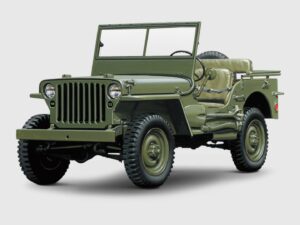Jeep, a brand synonymous with rugged off-road vehicles, has come a long way since its humble beginnings during World War II. The evolution of Jeep is not only a story of technological advancements but also a testament to its versatility, resilience, and staying power. This article takes a deep dive into Jeep’s journey, tracing its path from the battlefields of the 1940s to its modern status as a symbol of adventure, freedom, and durability.
The Origins of Jeep: World War II (1940s)
The Jeep’s history is rooted in necessity and innovation during one of the most tumultuous periods in modern history — World War II. In 1940, as the U.S. prepared for potential involvement in the war, the military recognized the need for a lightweight, durable reconnaissance vehicle. Several car manufacturers, including Bantam, Willys-Overland, and Ford, competed to design a vehicle that could handle the rough terrains of Europe and the Pacific theater.
The specifications for the vehicle were daunting: it needed to weigh no more than 1,300 pounds, have four-wheel drive, and carry a 660-pound payload. Bantam submitted the first prototype, the Bantam Reconnaissance Car, but its small production capacity led to Willys-Overland and Ford being brought into the fold. Willys-Overland’s design, known as the Willys MB, ultimately became the base model for the military Jeep, but Ford’s production capacity allowed it to produce its version, the GPW, based on the Willys design.
The result was the Willys MB, an iconic vehicle affectionately known as the “Jeep.” While the origin of the name “Jeep” is debated, many believe it is derived from the military designation “GP” (General Purpose), though others claim it came from a character in the Popeye comic strip named “Eugene the Jeep.”
By the end of World War II, more than 640,000 Jeeps had been produced, and the vehicle was celebrated for its toughness, versatility, and reliability. It was instrumental in the war effort, carrying soldiers and supplies across treacherous landscapes, and even serving as ambulances in combat zones.
Post-War Jeep: Civilian Adaptation (1945-1950s)

After World War II, Willys-Overland quickly recognized the potential of Jeep beyond military use. In 1945, the company launched the CJ-2A, the first civilian Jeep (CJ stood for “Civilian Jeep“). The CJ-2A maintained many of the features that made the Willys MB successful, including four-wheel drive, but it was adapted for civilian applications with the addition of features like a tailgate, larger headlights, and improved comfort.
The post-war years saw Jeep grow in popularity among farmers, ranchers, and other outdoor enthusiasts who needed a rugged vehicle for work and recreation. The CJ series, particularly models like the CJ-3A and CJ-3B, became known for their reliability and ability to navigate challenging terrains, making them ideal for rural and off-road driving.
Willys also expanded the Jeep brand during this period, creating new models such as the Willys Wagon and Willys Jeep Truck. These vehicles helped cement Jeep’s reputation as a versatile brand capable of producing both work and utility vehicles.
The 1960s: Expanding the Jeep Lineup
By the 1960s, Jeep had become a cultural icon, particularly in the United States, where it was associated with freedom, ruggedness, and outdoor adventure. In 1963, Kaiser Motors, which had acquired Willys-Overland in 1953, introduced a significant milestone in Jeep’s evolution: the Jeep Wagoneer. The Wagoneer was a revolutionary vehicle for its time, combining the off-road capabilities Jeep was known for with the comfort and luxury of a family vehicle.
The Wagoneer is often credited as the first true sport utility vehicle (SUV), a precursor to the modern SUVs that dominate the roads today. With its independent front suspension, automatic transmission, and stylish design, the Wagoneer helped redefine what a utility vehicle could be, making it appealing not only to off-road enthusiasts but also to suburban families.
Jeep continued to innovate throughout the 1960s, introducing models such as the Jeep Gladiator pickup truck in 1962 and the Jeepster Commando in 1966. These vehicles helped expand Jeep’s market beyond off-road and military applications to include recreational and everyday use.
The 1970s and 1980s: AMC and the Introduction of the Jeep Cherokee

The 1970s marked another turning point in Jeep’s evolution. In 1970, American Motors Corporation (AMC) acquired Jeep, bringing a new era of innovation and marketing to the brand. Under AMC’s ownership, Jeep continued to grow in popularity, with the introduction of key models that would shape the future of the brand.
One of the most important models from this period was the Jeep Cherokee, introduced in 1974. Originally based on the Wagoneer platform, the Cherokee was designed to appeal to younger buyers looking for a smaller, sportier version of the Wagoneer. It featured a two-door design, four-wheel drive, and a powerful engine, making it a popular choice for off-road enthusiasts and suburban drivers alike.
In 1984, Jeep introduced the Cherokee XJ, which is widely regarded as one of the most influential SUVs ever made. The XJ was a compact SUV with unibody construction, a significant departure from the traditional body-on-frame design used in most off-road vehicles at the time. The unibody design made the XJ lighter, more fuel-efficient, and more comfortable to drive on paved roads while still maintaining the off-road capabilities Jeep was known for.
The Cherokee XJ’s success helped solidify Jeep’s reputation as a leader in the SUV market, and it became one of the most popular and enduring models in the brand’s history, remaining in production until 2001.
The 1990s: Chrysler Acquisition and the Rise of the Grand Cherokee
In 1987, AMC was acquired by Chrysler, marking the beginning of a new chapter for Jeep. Under Chrysler’s ownership, Jeep continued to expand its lineup, catering to a growing market of SUV buyers.
One of the most significant developments during this period was the introduction of the Jeep Grand Cherokee in 1992. The Grand Cherokee was designed to be a more luxurious, higher-performance SUV than the Cherokee, targeting buyers who wanted both off-road capability and premium features. The Grand Cherokee quickly became a best-seller and is now considered one of the most successful models in Jeep’s history.
The Grand Cherokee helped Jeep transition from being a niche off-road brand to a mainstream automotive powerhouse. It combined comfort, luxury, and cutting-edge technology with Jeep’s traditional ruggedness, making it a hit among both suburban families and off-road enthusiasts.
2000s and Beyond: Jeep’s Global Expansion and Modern Models

The 2000s marked a period of global expansion for Jeep. The brand became more accessible to international markets, and its lineup grew to include more models catering to different tastes and needs. In 2007, Jeep introduced the Wrangler JK, an updated version of its iconic Wrangler model, which retained its off-road prowess while offering more comfort and modern technology.
The Wrangler continued to be Jeep’s flagship model, beloved for its classic design and unparalleled off-road capabilities. Over the years, the Wrangler has seen numerous updates, but its core identity as a rugged, go-anywhere vehicle has remained unchanged.
In 2017, Jeep introduced the next generation of the Wrangler, the JL, which included advanced technology, improved fuel efficiency, and enhanced off-road performance. The JL Wrangler, with its fold-down windshield and removable doors, harkens back to the original military Jeep while offering modern conveniences like touchscreen infotainment systems and driver-assistance features.
Another significant addition to the Jeep lineup in recent years is the Jeep Gladiator, a midsize pickup truck introduced in 2019. The Gladiator combines the off-road capabilities of the Wrangler with the utility of a pickup truck, making it one of the most versatile vehicles in Jeep’s history.
Conclusion: Jeep’s Enduring Legacy

From its origins on the battlefields of World War II to its status as a global icon of freedom and adventure, Jeep has evolved into one of the most recognizable and beloved automotive brands in the world. Its journey is a testament to innovation, resilience, and the ability to adapt to changing markets while staying true to its roots.
Today, Jeep offers a wide range of vehicles, from the rugged Wrangler to the luxurious Grand Cherokee, catering to a diverse audience of drivers. As the automotive industry continues to evolve, one thing is certain: Jeep will remain a symbol of exploration, freedom, and adventure for generations to come.

